FRANK THORNE, RED SONJA, GHITA—GONE
But Never Forgotten
THORNE, A LEGENDARY COMIC BOOK ARTIST best known for his work on Marvel’s Red Sonja, died March 7 at the age of 90, followed within six hours by the death of his wife, Marilyn, according to fellow comic book artist Walter Simonson. The cause of death was not immediately released.
Born in 1930, Thorne began his comics career drawing for Standard Comics in 1948. His early work included newspaper strips as well as comic books— Perry Mason, Flash Gordon, Green Hornet, Tom Corbett Space Cadet, Tomahawk, Mighty Samson, and Enemy Ace.
And then came Red Sonja.
The Red Sonja solo series ran for 15 issues from January 1977 to May 1979. Thorne later went on to create several erotic fantasy comics, writing and illustrating Moonshine McJugs for Playboy, Lann for Heavy Metal and Danger Rangerette for National Lampoon. He created miniseries Ribit for Comico and several graphic novels for Fantagraphics Books, including Ghita of Alizarr, The Iron Devil and The Devil’s Angel.
Thorne
said people commented on the attractiveness on the women he drew, and when he
found success with Red Sonja, he discovered his niche. 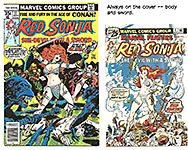
“Shoot, you’ve got a talent for drawing women. You should keep drawing women,” he said he was told, “which I have been doing since then,” he concluded with a chuckle.
Thorne won several awards, including a National Cartoonists Society award in 1963, a San Diego Inkpot Award in 1978 and a Playboy editorial award. But his signal achievement in cartooning was in the creation of Ghita of Alizarr, a more fully developed version of Red Sonja.
These were his most memorable characters, imbued with exuberant life in the best tradition of cartooning.
It was his imagination that gave to the airy nothing of his erotic fantasies a local habitation, Alizarr, and a name, Ghita. And both came to unabashed and ribald life in the pages of one of Jim Warren's black-and-white comic books. As newsstand periodicals, Warren's magazines were mainstream by sufferance rather than by hallowed custom. In an age of rampant superheroics, they shunned longjohn legions, offering instead some science fiction, a little supernatural horror, and a lady vampire in scanty attire. And they aimed at adults.
Thorne's Ghita burst forth upon the reading audience in the seventh issue of Warren’s magazine 1984 ("Provocative Illustrated Adult Fantasy") in August 1979. About a warrior woman in an ancient (or future?) age beyond our ken, Ghita's story was serialized in the magazine for seven issues; and then Thorne, who owned the character, reissued all seven installments in an album entitled Ghita of Alizarr.
At the time of her debut, Ghita was widely viewed as a raunchy reincarnation of
Thorne's Red Sonja, a skimpily armored female comrade-in-arms (so to speak) in Marvel's
comics featuring Robert E. Howard's brawny sword and sorcery barbarian, Conan. With
writer Roy Thomas in the mid-1970s, Thorne had done seventeen Red Sonja books, and he frankly admitted his infatuation with the character, "my madness for Sonja.” In the Afterward of The Art of Frank Thorne, the cartoonist wrote:
To cast Red Sonja aside as a sexual dream of adolescence is missing the thrust of this mythic figure. Granted, Sonja is that dream, but beyond lie the Himalayas. True, amongst those peaks roams this magnificent, near naked woman. The child's infatuation with nudity is there, combined with the mature wisdom of combat. Venus with a sword, stalking the once and future kingdoms. She is formed energy, she is the sound that Siegfried harkened to. Red Sonja represents the total possibilities in all of us.
Thorne saw Red
Sonja as "the ultimate woman," "the epochal female." In
stage shows for comic book conventions, Thorne dressed as a wizard, telling the
mystical story of Sonja and then invoking her in the flesh (played by actresses
or models or, more often than not, by cartoonist Wendy Pini, who was on the
cusp of fame herself as the creator of the Elfquest series of comic
books). Thorne's special affection for the character shone in the pages
of the comic books; if ever the female face and form were lovingly rendered, it
was in Red Sonja. 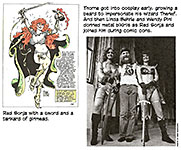
But Roy Thomas didn’t like Thorne’s treatment of the character. Too sexy. Too baby-doll in the face. Nor did Thomas participate in the myth that Thorne was enthralled by. And so Thorne was eased off the book in 1978. And a good thing, too, because Ghita—a more fully realized version of Thorne’s vision of Sonja, written as well as drawn by him—would not have appeared among us otherwise.
And Ghita is, indeed, the spitting image of Red Sonja. She looks like Sonja, and we see
more of her: she's discarded the tin bikini armor that Sonja affected, and although she picks up and dons an occasional piece of armor, mostly, she's naked. Like Sonja, Ghita is a swordswoman in a world of swords and sorcery. But there similarities end. In the unrestrained pages of the Warren magazine, Thorne's vision of a swordswoman's life in an antediluvian world took more sexually explicit form than it was permitted in Marvel's books under Thomas' direction.
When we first meet Ghita, King Khalia's favorite harlot, she's lounging naked in the royal bedchamber with an old friend and fellow thief, Thenef, a would-be wizard whose slight of hand and mumbo jumbo have earned him a place as a court mage.
Echoes of ritual customs can be seen in Thorne's Ghita. But here the fecundity of nature is expressed in terms of female sexuality. And in Ghita, the female subsumes the male, taking possession of it, or being possessed by it.
Ghita comes upon the sword of the fabled warrior-king Khan-Dagon and immediately recognizes its phallic character.
“Eternally
erect, forever hard,” she says. “I will make love to it,” she declares and
proceeds at once to do so, thereby making Khan-Dagon and his sword symbolically
one—and taking possession of both. (And in the extravagance of this conceit we
can see Thorne’s byzantine if earthy sense of the human comedy running
rampant.) 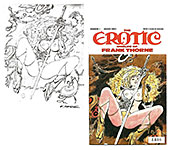
Following this extraordinary feat, Ghita is transformed. Inseminated with the phallic conquering spirit of the dead warrior-king, she is no longer the courtesan: she is now a blood-thirsty swordswoman, bent on battling the invading trolls and winning Alizarr back. By the end of this adventure, she has done all of that.
So much for heavy meaning. Too much, in fact.
Ghita is more profane than profound. After all is said and done, it is less the action of the tale, for all its echoes of antiquity, than its atmosphere that constitutes the captivating charm of Ghita of Alizarr. And the atmosphere emanates from the personality of Ghita.
Thanks to the license granted to Warren artists and writers, Ghita is a ribald original.
As Thorne says, she is "the outrageous warrior woman of Alizarr, the Winged Victory of the
sexual revolution. Ghita is absurd— a libidinous clown of heavenly proportions in an ancient
festering world of benign and lethal nightmares."
She is "the final lewd monument to a battle long over."
In Thorne's purposefully overblown language we see the rollicking sense of fun that pervades the work.
Thorne has endowed his creation with a voluptuous body and the living, breathing personality of a street-wise trollop who has a lusty appreciation of her trade. Says Thorne: "Ghita burps, boozes, copulates, wields a sword with deadly accuracy, breaks wind, swears like a peglegged Philistine, and on occasion runs around joyously naked. Hardly ladylike behavior. Ghita of Alizarr is no lady— but she has class."
She
speaks a bawdy argot, suggesting the arcane lingo of the streets of a long
forgotten city. Raucous and ribald, her sexual assault on the world
celebrates both appetite and epidermis. Her forthright sexuality is
reminiscent of no less than Joyce's famed Molly Bloom. To her old friend,
the fraud wizard Thenef, she's the champion whore of Alizarr, a profane earth
mother, whose sexual vitality animates the world. 
Among us there are doubtless those who would find Ghita of Alizarr pornographic. No surprise. But Ghita is not, by most definitions, pornographic. The function of pornography is solely to excite. Ghita does that— but the book also delights. Joyfully. In pornography, there is little evidence of artistic concern; in Ghita, there is ample evidence of Thorne's endeavor to make a work of art— in character development, in language, and in the pictures he draws. A successful endeavor.
Thorne's delicate lines lovingly limn the body of his heroine, but the same lines also
create the world of Alizarr— and almost as lovingly. The carefully rendered setting with
appropriate accoutrements is as important to Thorne's tale as his central character. Enhancing the arcane atmosphere that permeates the work is the decorative filigree page design that Thorne employs, giving the book a strangely Oriental motif that speaks of a distant time and place.
For me, the book is a highly moral one. In the face of Ghita's frank and uninhibited
acceptance and enjoyment of human sexuality, furtive guilt about such matters scurries into
the shadows and disappears. Such openness banishes mystery with its accompanying aura of
dirty secrecy. To foster acceptance of any aspect of the human condition, to nurture
enjoyment of it, and to vanquish meaningless guilt seem to me to be acts of high morality:
such acts elevate the human spirit. If this be pornography, we need more of it.
Ghita is vulnerable to the charge of sexism, too, I suppose. But if we examine Ghita's character and actions rather than ogle her flesh, we find the strong and independent personality of a champion of female freedom. She is no kind of victim. She has the air of one who commands her own life: she proclaims her freedom and enacts it.
In her book’s Afterword, Thorne is a remarkable witness to the creative process. He describes his creation with grace and wit. And he also testifies to his affection for and involvement with the character.
"This fey heroine has seized my inner being," Thorne writes; "I cannot help myself. I must draw her and make her speak."
He goes on: "In Ghita's adventures, I have crafted Thenef the wizard in my own image. I have allowed my hair and beard to grow to flowing lengths as a device to make it easier to imagine myself as Ghita's comrade-in-arms and ginmead-guzzling cohort. Thus I gain entry into her world."
Together, Thorne says, the characters are "fragmented aspects of their creator's personality. I, as the wizard, indulge in her as a fantasy, but the guilt of betraying the most splendid real life partnership forbids me to speak of loving the wench. To play out in reality the perfumed urges within all men would be unconscionable, but not unimaginable."
Thorne's imagination and his craft have given more than two-dimensional life to his
erotic fantasy: his creative and personal involvement have invested those two dimensions with such affectionate energy as to give us a clutch of memorable characters, rounded and whole personalities, brimming with vitality and joie de vivre. No cartoonist could aspire to more.
After Ghita (and sometimes contemporaneously with her), Thorne pursued his erotic muse in other titles and characters. Lann (in the high tech future), Ribit (a love story without sex), Astra, and a couple others mentioned below. The most widely circulated was Moonshine McJugs, a one-page comic strip in Playboy that featured a hillbilly girl’s jugs and her seemingly inexhaustible appetite for sex with the entire male population of Pork Hollar.
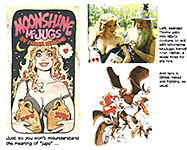 |
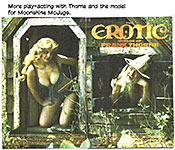 |
 |
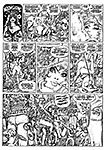 |
By 1990, Fantagraphics was producing Thorne’s sexy comic strip
s in a magazine entitled The Erotic Worlds of Frank Thorne. The complete 1980s run of Moonshine McJugs was published in Nos.2 and 3 of this magazine, including unpublished finished art that Playboy had rejected, plus hitherto unpublished penciled strips. I have six issues of the magazine, from the first in October 1990 to No.6 in June 1991. If there were more, I don’t know about them.
But I doubt there were more because more of Thorne’s erotic imagination was soon on display in another Fantagraphics comicbook, Iron Devil, from March1993 to March 1994; then Devil’s Angel, at least one issue in January 1995. These featured new characters and a much more overt sexual orientation with sequences depicting copulation in genital detail and as much cock-sucking as possible.
“Iron Devil is pure smut,” Thorne said with a chuckle during an interview with Howard LeRoy Davis. “But it’s beautiful smut—at least that’s what I’ve been told. ‘The Iron Devil series was the most beautiful pornography ever drawn...’ Or that’s the way I’ve heard several people talk about it.
“And I just uncorked and let it flow out. Those were my days when I could think of sex. ... I don’t think about it much any more ... but I still love to drawn the ladies. ... With age, you do think about it,” he added, correcting himself, “— but it’s different.”
Expertly, lovingly, drawn but they lacked the rollicking sense of humor that animated Ghita and Moonshine.
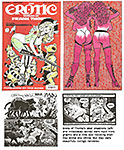 |
 |
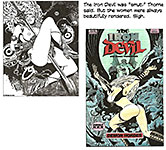 |
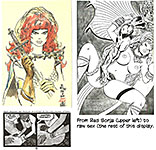 |
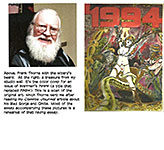 |
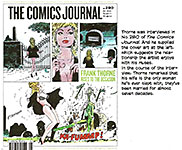 |
The most recent publication celebrating Thorne’s women is Frank Thorne’s Battling Beauties (128 9x12-inch pages, color; 2017 Hermes Press hardcover, $60), a collection of his art and of Howard LeRoy Davis’ insightful (albeit undated) interviews with Thorne.
Davis reprints a Thorne reverie on sex and feminity from the Ken Pierce book of Lann—:
“There I am, in front of a steamy dive on sin strip in downtown Port Neon, jiving the old come-on. Step right up to Neon-Six! It’s the venerable carny pitch, and this, folks, is show biz. N-6 and its famous Port Neon may seem a far jog from Alizarr, abode of Ghita, my warrior goddess of the Antedeluvian Age, and a pace from Pork Holler, home of my deep country maid Moonshine McJugs, but its all pure burlesque. Each is an aromatic and untidy platform for the display of pulchritude.
“I crouch before the altar, a poor acolyte trembling at the majestic universe of brimming boobs, well-turned thighs, and shapely glutei maximi! I swoon at the shore of the ocean of mascara-eyed maidens. I am wasted with the thought of legion of ladies out there, in the buff, floating over the mist-shrouded fens, bathing in sylvan pools, making love. ... I faint away at the image.
“To confess is to ponder the dark age of my drawing Flash Gordon. It bothered me that Flash didn’t have a belly button! Were I even to hint at a navel, an editor would remove the vile cavity with a pious fervor. Perhaps Flash was made of plastic like Glitch, Lann’s custodial droid. I’ve seen to it that on Neon-Six, even plastic people have belly buttons. Blame it on Dale Arden.”
Comic book writer and erstwhile DC publisher Paul Levitz shared a tribute to Thorne on Facebook—:
Bidding farewell to Frank Thorne, an artist who progressively developed his style into a more and more personal expression. I had the pleasure of working with Frank in his later DC days, when he did some magnificent work for the mystery titles, and stepped in to pencil for Jim Aparo on The Spectre, matching his storytelling approach carefully to Jim’s.
But Frank had the best time of his career on Marvel’s Red Sonja, who he made both powerful and sexy. He was probably the first working mainstream [artist] to revel in [cosplay] becoming the Wizard who acted with Wendy Pini’s Sonja at show after show.
A man of talent, charm and great wit. Good journey onward, Frank, you will be long remembered.
